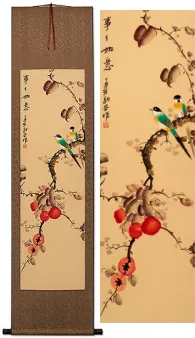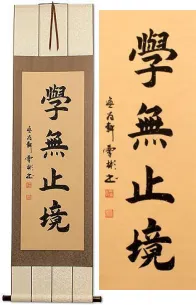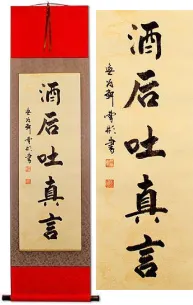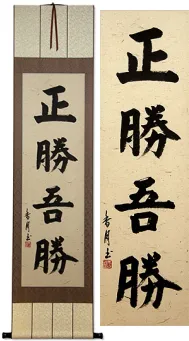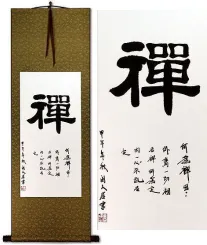Many custom options...
And formats...

Not what you want?
Try other similar-meaning words, fewer words, or just one word.
Everything is Transient in Chinese / Japanese...
Buy an Everything is Transient calligraphy wall scroll here!
Personalize your custom “Everything is Transient” project by clicking the button next to your favorite “Everything is Transient” title below...
Impermanence
無常 is the state of being “not permanent,” “not enduring,” transitory, or evolving.
It can also mean variable or changeable. In some contexts, it can refer to a ghost that is supposed to take a soul upon death. Following that, this term can also mean to pass away or die.
In the Buddhist context, this is a reminder that everything in this world is ever-changing, and all circumstances of your life are temporary.
If you take the Buddhist philosophy further, none of these circumstances are real, and your existence is an illusion. Thus, the idea of the eternal soul is perhaps just your attachment to your ego. Once you release your attachment to all impermanent things, you will be on your way to enlightenment and Buddhahood.
Language notes for this word when used outside the context of Buddhism:
In Korean Hanja, this means uncertainty, transiency, mutability, or evanescent.
In Japanese, the definition orbits closer to the state of being uncertain.
Mono no Aware
This translates as “the pathos of things,” “an empathy toward things,” or “a sensitivity to ephemera.”
物の哀れ is a Japanese proverb for the awareness of impermanence, or transience of things.
Both things and the emotions about those things do not last forever.
Note: Because this selection contains some special Japanese Hiragana characters, it should be written by a Japanese calligrapher.
Mujo no Kaze / Wind of Impermanence
無常の風 is an old Japanese proverb that means the wind of impermanence or the wind of change in Japanese.
This can refer to the force that ends life, like the wind scattering a flower's petals. Life is yet another impermanent existence that is fragile, blown out like a candle.
The first two characters mean uncertainty, transiency, impermanence, mutability, variable, and/or changeable.
In some Buddhist contexts, 無常 can be analogous to a spirit departing at death (with a suggestion of the impermanence of life).
The last two characters mean “of wind” or a possessive like “wind of...” but Japanese grammar will have the wind come last in the phrase.
This in-stock artwork might be what you are looking for, and ships right away...
Gallery Price: $108.00
Your Price: $59.88
Gallery Price: $180.00
Your Price: $99.88
Gallery Price: $100.00
Your Price: $49.88
Gallery Price: $100.00
Your Price: $58.88
Gallery Price: $100.00
Your Price: $58.88
Gallery Price: $180.00
Your Price: $99.88
Gallery Price: $178.00
Your Price: $98.88
Gallery Price: $168.00
Your Price: $92.88
Gallery Price: $200.00
Your Price: $122.88
Gallery Price: $108.00
Your Price: $59.88
Not the results for everything is transient that you were looking for?
Below are some entries from our dictionary that may match your everything is transient search...
| Characters If shown, 2nd row is Simp. Chinese |
Pronunciation Romanization |
Simple Dictionary Definition |
Variations: |
ukiyohayume うきよはゆめ |
(expression) (proverb) (See 浮世・1) life is but a dream; this too shall pass; everything is transient |
無常 无常 see styles |
wú cháng wu2 chang2 wu ch`ang wu chang mujou / mujo むじょう |
More info & calligraphy: Impermanence(n,adj-na,adj-no) {Buddh} (ant: 常住・2) uncertainty; transiency; impermanence; mutability anitya. Impermanent; the first of the 三明 trividyā; that all things are impermanent, their birth, existence, change, and death never resting for a moment. |
無常の風 see styles |
mujounokaze / mujonokaze むじょうのかぜ |
More info & calligraphy: Mujo no Kaze / Wind of Impermanence |
三教 see styles |
sān jiào san1 jiao4 san chiao sankyou; sangyou / sankyo; sangyo さんきょう; さんぎょう |
the Three Doctrines (Daoism, Confucianism, Buddhism) (1) Shinto, Buddhism and Confucianism; the three religions; (2) Confucianism, Buddhism and Taoism; (3) Buddhism, Shinto and Christianity; (given name) Mitsunori The three teachings, i.e. 儒, 佛 (or 釋), and 道Confucianism, Buddhism, and Taoism; or, 孔, 老, 釋 Confucianism, Taoism (aIso known as 神敎), and Buddhism. In Japan they are Shinto, Confucianism, and Buddhism. In Buddhism the term is applied to the three periods of Śākyamuni's own teaching, of which there are several definitions: (1) The Jiangnan 南中 School describe his teaching as (a) 漸progressive or gradual; (b) 頓 immediate, i.e. as one whole, especially in the 華嚴經; and (c) 不定 or indeterminate. (2) 光統 Guangtong, a writer of the Iater Wei dynasty, describes the three as (a) 漸 progressive for beginners, i.e. from impermanence to permanence, from the void to reality, etc.; (b) 頓 immediate for the more advanced; and (c) 圓complete, to the most advanced, i.e. the Huayan as above. (3) The 三時敎q.v. (4) The 南山 Southern school deals with (a) the 性空of Hīnayāna; (b) 相空of Mahāyāna; and (c) 唯識圓 the perfect idealism. v. 行事鈔中 4. Tiantai accepts the division of 漸, 頓, and 不定 for pre-Lotus teaching, but adopts 漸 gradual, 頓 immediate, and 圓 perfect, with the Lotus as the perfect teaching; it also has the division of 三藏敎 , 通敎 , and 別敎 q.v. |
三輪 三轮 see styles |
sān lún san1 lun2 san lun sanrin さんりん |
three wheels; (p,s,f) Miwa The three wheels: (1) The Buddha's (a) 身 body or deeds; (b) 口 mouth, or discourse; (c) 意 mind or ideas. (2) (a) 神通 (or 變) His supernatural powers, or powers of (bodily) self-transformation, associated with 身 body; (b) 記心輪 his discriminating understanding of others, associated with 意 mind; (c) 敎誡輪 or 正敎輪 his (oral) powers of teaching, associated with 口. (3) Similarly (a) 神足輪 ; (b) 說法輪 ; (c) 憶念輪 . (4) 惑, 業, and 苦. The wheel of illusion produces karma, that of karma sets rolling that of suffering, which in turn sets rolling the wheel of illusion. (5) (a) Impermanence; (b) uncleanness; (c) suffering. Cf. 三道. |
九道 see styles |
jiǔ dào jiu3 dao4 chiu tao kudō |
idem 九有情居.; The nine truths, or postulates: impermanence; suffering; voidness (or unreality of things); no permanent ego, or soul; love of existence or possessions, resulting in suffering; the opposite (or fear of being without them), also resulting in suffering; the cutting off of suffering and its cause; nirvāṇa with remainder still to be worked out; complete nirvāṇa. |
二相 see styles |
èr xiàng er4 xiang4 erh hsiang nisou / niso にそう |
(noun - becomes adjective with の) two-phase The two forms, or characteristics, of the bhutatathata, universal and particular. The 起信論 gives (a) 淨智相 pure wisdom, cf. ālaya-vijñāna, out of whose primary condition arise (b) 不思議用相 inconceivable, beneficial functions and uses. The same śāstra gives also a definition of the 眞如 as (a) 同相 that all things, pure or impure, are fundamentally of the same universal, e.g. clay which is made into tiles; (b) 異相 but display particular qualities, as affected by pure or impure causes, e.g. the tiles. Another definition, of the 智度論 31, is (a) 總相 universals, as impermanence; (b) 別相 particulars, for though all things have the universal basis of impermanence they have particular qualities, e.g. earth-solidity, heat of fire, etc. |
二鳥 二鸟 see styles |
èr niǎo er4 niao3 erh niao nichou / nicho にちょう |
(female given name) Nichō The drake and the hen of the mandarin duck who are always together, typifying various contrasted theories and ideas, e.g. permanence and impermanence, joy and sorrow, emptiness and non-emptiness, etc. |
井河 see styles |
jǐng hé jing3 he2 ching ho igawa いがわ |
(surname) Igawa Like the well and the river', indicating the impermanence of life. The 'well ' refers to the legend of the man who running away from a mad elephant fell into a well; the 'river ' to a great tree growing on the river bank yet blown over by the wind. |
八魔 see styles |
bā mó ba1 mo2 pa mo hachima |
The eight Māras, or destroyers: 煩惱魔 the māras of the passions; 陰魔 the skandha-māras, v. 五陰; 死魔 death-māra ; 他化自在天魔 the māra-king. The above four are ordinarily termed the four māras: the other four are the four Hīnayāna delusions of śrāvakas and pratyekabuddhas, i.e. 無常 impermanence; 無樂 joylessness; 無我 impersonality; 無淨 impurity; cf. 八顚倒. |
四山 see styles |
sì shān si4 shan1 ssu shan yotsuyama よつやま |
(place-name) Yotsuyama Like four closing-in mountains are birth, age, sickness, and death; another group is age, sickness, death, and decay (衰, i. e. of wealth, honours, etc., or 無常 impermanence). |
四蛇 see styles |
sì shé si4 she2 ssu she shida |
idem 四毒蛇. The Fanyimingyi under this heading gives the parable of a man who fled from the two bewildering forms of life and death, and climbed down a rope (of life) 命根, into the well of impermanence 無常, where two mice, night and day, gnawed the rattan rope; on the four sides four snakes 四蛇 sought to poison him, i. e. the 四大 or four elements of his physical nature); below were three dragons 三毒龍 breathing fire and trying to seize him. On looking up he saw that two 象 elephants (darkness and light) had come to the mouth of the well; he was in despair, when a bee flew by and dropped some honey (the five desires 五欲) into his mouth, which he ate and entirely forgot his peril. |
殺鬼 杀鬼 see styles |
shā guǐ sha1 gui3 sha kuei satsuki さつき |
(female given name) Satsuki To slay demons; a ghost of the slain; a murderous demon; a metaphor for impermanence. |
無住 无住 see styles |
wú zhù wu2 zhu4 wu chu mujuu / muju むじゅう |
temple lacking a priest; (personal name) Mujuu Not abiding; impermanence; things having no independent nature of their own, they have no real existence as separate entities. |
豆佉 see styles |
dòu qū dou4 qu1 tou ch`ü tou chü zukya |
(Buddhism) suffering (from Sanskrit "dukkha") duḥkha, trouble, suffering, pain, defined by 逼惱 harassed, distressed. The first of the four dogmas, or 'Noble Truths' 四諦 is that all life is involved, through impermanence, in distress. There are many kinds of 苦 q. v. |
電影 电影 see styles |
diàn yǐng dian4 ying3 tien ying denei / dene でんえい |
movie; film; CL:部[bu4],片[pian4],幕[mu4],場|场[chang3] (1) (in Chinese) (See 映画) movie; film; (2) (obsolete) lightning Impermanence of all things like lightning and shadow. |
一法印 see styles |
yī fǎ yìn yi1 fa3 yin4 i fa yin ippōin |
The seal or assurance of the one truth or law, see 一如 and 一實; the criterion of Mahāyāna doctrine, that all is bhūtatathatā, as contrasted with the Hīnayāna criteria of impermanence, non-personality, and nirvāṇa. |
三法印 see styles |
sān fǎ yìn san1 fa3 yin4 san fa yin sanbouin / sanboin さんぼういん |
Dharma seals; three marks of existence (suffering, impermanence, non-Self) idem 三印. |
不淨輪 不淨轮 see styles |
bù jìng lún bu4 jing4 lun2 pu ching lun fujōron |
One of the three 輪: impermanence, impurity, distress 無常, 不淨, 苦. |
二無常 二无常 see styles |
èr wú cháng er4 wu2 chang2 erh wu ch`ang erh wu chang ni mujō |
Two kinds of impermanence, immediate and delayed. 念念無常 things in motion, manifestly transient; 相續無常 things that have the semblance of continuity, but are also transient, as life ending in death, or a candle in extinction. |
五門禪 五门禅 see styles |
wǔ mén chán wu3 men2 chan2 wu men ch`an wu men chan gomon zen ごもんぜん |
(out-dated kanji) (Buddhist term) five approaches to meditation; five objects of meditation idem 五停心觀; there is also a fivefold meditation on impermanence, suffering, the void, the non-ego, and nirvana. |
四句執 四句执 see styles |
sì jù zhí si4 ju4 zhi2 ssu chü chih shikushū |
The four tenets held by various non-Buddhist schools: (1) the permanence of the ego, i. e. that the ego of past lives is the ego of the present; (2) its impermanence, i. e. that the present ego is of independent birth; (3) both permanent and impermanent, that the ego is permanent, the body impermanent; (4) neither permanent nor impermanent; that the body is impermanent but the ego not impermanent. |
四法印 see styles |
sì fǎ yìn si4 fa3 yin4 ssu fa yin shihouin / shihoin しほういん |
{Buddh} (See 諸行無常,諸法無我,一切皆苦,涅槃寂静) the four signs of orthodox Buddhism The seal or impression of the four dogmas, suffering, impermanence, non-ego, nirvana, see 四法本末. |
四行相 see styles |
sì xíng xiàng si4 xing2 xiang4 ssu hsing hsiang shi gyōsō |
To meditate upon the implications or disciplines of pain, unreality, impermanence, and the non-ego. |
涅槃印 see styles |
niè pán yìn nie4 pan2 yin4 nieh p`an yin nieh pan yin nehan in |
(涅槃寂靜印) The seal or teaching of nirvāṇa, one of the three proof that a sutra was uttered by the Buddha, i.e. its teaching of impermanence, non-ego, nirvāṇa; also the witness within to the attainment of nirvāṇa. |
無上忍 无上忍 see styles |
wú shàng rěn wu2 shang4 ren3 wu shang jen mujō nin |
The highest patient equanimity in receiving the truth; also, to believe the truth of impermanence without doubt, v. 十忍. |
無常依 无常依 see styles |
wú cháng yī wu2 chang2 yi1 wu ch`ang i wu chang i mujō e |
The reliance of the impermanent, i.e. Buddha, upon whom mortals can rely. |
無常修 无常修 see styles |
wú cháng xiū wu2 chang2 xiu1 wu ch`ang hsiu wu chang hsiu mujō shu |
cultivation of (awareness of) impermanence |
無常偈 无常偈 see styles |
wú cháng jié wu2 chang2 jie2 wu ch`ang chieh wu chang chieh mujō ge |
Verse of Impermanence |
無常堂 无常堂 see styles |
wú cháng táng wu2 chang2 tang2 wu ch`ang t`ang wu chang tang mujō dō |
無常院; 延壽堂; 湼槃堂 The room where a dying monk was placed, in the direction of the sunset at the north-west corner. |
Click here for more everything is transient results from our dictionary
The following table may be helpful for those studying Chinese or Japanese...
| Title | Characters | Romaji (Romanized Japanese) | Various forms of Romanized Chinese | |
| Impermanence | 無常 无常 | mujou / mujo | wú cháng / wu2 chang2 / wu chang / wuchang | wu ch`ang / wuchang / wu chang |
| Mono no Aware | 物の哀れ | mono no awa-re mononoawa-re | ||
| Mujo no Kaze Wind of Impermanence | 無常の風 | mu jou no kaze mujounokaze mu jo no kaze | ||
| In some entries above you will see that characters have different versions above and below a line. In these cases, the characters above the line are Traditional Chinese, while the ones below are Simplified Chinese. | ||||
Successful Chinese Character and Japanese Kanji calligraphy searches within the last few hours...



